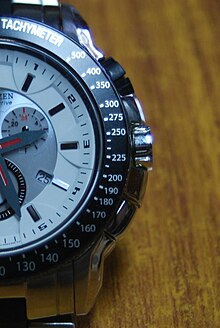This article relies largely or entirely on a single source. (March 2023) |

A tachymeter (pronounced /tæˈkɪmətər/) is a scale sometimes inscribed around the rim of an analog watch with a chronograph. It can be used to conveniently compute the frequency in inverse-hours of an event of a known second-defined period, such as speed (distance over hours) based on travel time (distance over speed), or measure distance based on speed. The spacings between the marks on the tachymeter dial are therefore proportional to 1⁄t , where t is the elapsed time.
The function performed by a tachymeter is independent of the unit of distance (e.g. statute miles, nautical miles, kilometres, metres etc.) as long as the same unit of length is used for all calculations. It can also be used to measure the frequency of any regular event in occurrences per hour, such as the units output by an industrial process. A tachymeter is simply a means of converting elapsed time (in seconds per unit) to rate (in units per hour).